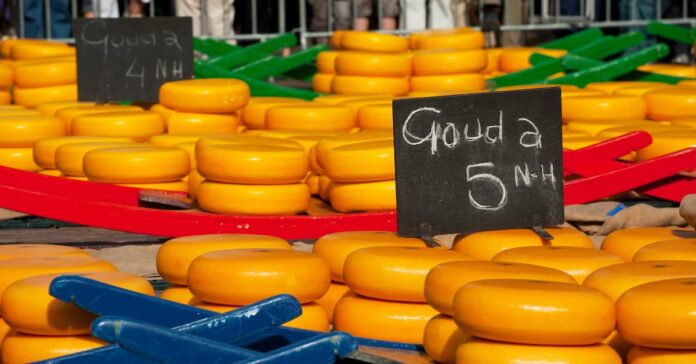Cheese. Let that roll off your tongue. Yum. There are more than 1,800 types of this humble dairy product around the world. There are cheese guilds, cheese awards, cheeses protected by law, and cheeses steeped in tradition. There is hard cheese, smelly cheese, runny cheese, and even moldy cheese. There is cheese that ought to be grated and sprinkled, other cheese that is simply perfect for melting and forming crispy layers, and lots of cheese that is perfect just on its own. It seems that the world runs on cheese. At the very least, it would not run half as enjoyably without it.
Every country in the world has its own cheese and tends to be proud of it. But there are some countries where cheese-making truly has been raised to an art form, with so many cheeses that picking a favorite results in severe stress.
I am a dedicated cheese lover — except for moldy cheese. I hate moldy cheese. But I shall let you onto a secret: I did not really enjoy cheese (bar the gooey, melted stuff on my pasta, pizza, or gratinated potatoes — basically, cooked cheese) until I went on a gourmet food walking tour in Hobart, Tasmania, of all places. Part of the walking tour was a cheese tasting and I thought, when in Rome, as you do, and tried them all. I never looked back. Then, I moved to France and really made up for lost time. So, lesson learned? It’s never too late to start loving cheese.
Here are some of my favorite destinations around the world for cheese lovers, in no particular order.
Brie cheese at the Eiffel Tower
Photo credit: Maria Vonotna / Shutterstock.com
1. Northern France
Camembert, Brie
Probably the most widely known and exported French cheeses are the two round-flat cheeses which are often mixed up by foreigners, looking reasonably similar. Camembert and brie are both from the gourmet heaven of northern France. As a very basic guideline, camembert is smaller and stronger tasting than brie, and is often baked as a delicious starter. Brie is milder, much larger, and often stuffed with delights such as truffle shavings. Both have a rind that is supposed to be eaten, not cut off.
Camembert hails from Normandy with many so-called fermes, or “cheese farms,” found across the county. They all offer a slightly different product, while the best brie can be found around Melun and Meaux on the Ile de France. But head to any good fromagerie in Paris, and they will have several options for both cheeses. Try my go-to cheesemonger: the small, but very knowledgeable Le Calendos on Rue Pierre Demours in the 17th arrondissement.
Saint-Nectaire is a semi-soft cheese prominent in eastern France.
Photo credit: page frederique / Shutterstock.com
2. Auvergne And Eastern France
Roquefort, Saint-Nectaire, Tommes, Comte
Funny enough, despite not liking blue cheese at all, this part of France makes my personal favorite cheese: Saint-Nectaire. Saint-Nectaire is a semi-soft cheese that either comes in a thicker gray rind or a softer orange rind. My local restaurant, Le Trois-Quart in Paris, always has a large round sitting on the bar. They’ll simply pass it to your table before dessert and you cut off as much as you want to; same price, regardless of your appetite.
Further to the east of France, you get the heartier mountain cheeses. From raclette to lovely tommes in numerous guises — made from cow’s, ewe’s, or goat’s milk — without this melted goodness, a winter vacation is just not the same. The hard Comte cheese is simply the most popular and eaten cheese in France, with, if you believe reports, some 57 pounds eaten per person every year! Taste it for yourself in the Jura Mountains and see if you agree.
Puglian burrata balls filled with fresh mozzarella and cream
Photo credit: barmalini / Shutterstock.com
3. Puglia, Italy
Burrata, Mozzarella
There is no summer salad — or pizza — without mozzarella, and burrata has also reached cult status in recent years. Both come from the south of Italy, in and around the lovely region of Puglia, with the best mozzarella made, strangely enough, from buffalo milk. Watching this cheese being made on a farm is quite a revelation, as it is quite mesmerizing. It’s even better, however, to sit on any Italian restaurant terrace, order a Caprese salad, and enjoy the mozzarella working its magic on fresh tomatoes with a few basil leaves. So simple, so good, and at the same time, it’s the Italian flag on a plate.
Parmigiano reggiano being made in Italy
Photo credit: barmalini / Shutterstock.com
4. Emilia-Romagna, Italy
Parmesan
I defy any household around the world to say they don’t have some parmesan in their fridge. Parmesan — a hard, mature cheese made under the strictest rules — is probably the cheese that the world knows best. Grate it on your pasta, serve it with figs, or drizzle it with balsamic vinegar. It is a staple food. Produced by some 800 farms in the northern parts of Italy, making an incredible 2 million pounds per year, the best-known is without a doubt Parmigiano Reggiano. A visit to one of their dairies is a must when in Italy. Did you know that leftovers from the parmesan production get fed to parma pigs, making the wonderful parma ham, otherwise known as prosciutto? So, while you are there, try eating a slice of ham with a slice of parmesan for a double-whammy.
Gouda cheese in Gouda, Netherlands
Photo credit: Celli07 / Shutterstock.com
5. Gouda, Netherlands
Gouda
I’ll always remember my first visit to the city of Gouda when I was a child. All of these white-clad people were wearing clogs and carrying long wooden troughs stacked with cheeses in the lovely setting of the old square. Dating back to 1395, the Gouda Cheese Market — held every Thursday morning between April and August — is still going strong, and so is the production of Gouda, the Netherlands’s largest export. Gouda is, in fact, acknowledged as one of the world’s favorite cheeses, probably due to its semi-hard-to-hard consistency and the slightly sweet but not too strong taste. While most Gouda is now produced in large anonymous factories, there are still a few small, private farms where you can see the product being made.
6. Alps, Switzerland
Emmentaler, Gruyere
Emmentaler, or Emmental cheese, is one with a long history dating all the way back to the 1300s. A medium-hard cheese with those famous holes created by carbon dioxide bubbles produced by bacteria, Emmentaler is a true all-rounder. It’s great to eat just like that — as a gratin, fried, or even as a soup. But Emmentaler is also the main ingredient that makes cheese fondue quintessentially the national dish of Switzerland. As well as the somewhat stronger gruyere cheese, these two make for a great fondue. Stick your piece of bread into the melted cheese goodness while playing games to see who drops theirs in first. When you find yourself in Zurich, or pretty much in any Swiss city, head to a traditional eatery, such as the Swiss Chuchi restaurant, for a cheesy treat.
Wensleydale cheese
Photo credit: Chatham172 / Shutterstock.com
7. England
Cheddar, Stilton, Wensleydale
I’m guessing that when you think of English cheese, it will be cheddar that is at the forefront of your mind. This well-known cheese also makes for a great destination at the Cheddar Gorge, a natural cave system that is not just great to see, but also has long played a role in the maturation of the cheese made in this Somerset region. Nowadays, there is hardly any country that does not produce cheddar, but Cheddar Gorge is still the original. Then, there is stilton cheese, my husband’s favorite. It is a crumbly blue cheese whose recipe and production are protected by law and can only be made in three counties: Derbyshire, Nottinghamshire, and Lincolnshire. It is best tasted with port wine.
And, not to forget, there is Wensleydale cheese, made famous by Wallace & Gromit. This is a lovely, crumbly cheese from Yorkshire which is eaten locally with — wait for it — fruit cake. Try it yourself in an artisan creamery in Hawes.
For a cheesy experience of the truly weird kind, head to Coopers Hill near the Cotswolds for a day of cheese rolling.
Manchego cheese portion
Photo credit: BigKnell / Shutterstock.com
8. La Mancha, Spain
Manchego
Undoubtedly the best-known and best-loved Spanish cheese, this one not only comes from the La Mancha region, but is also mentioned in Cervantes’s Don Quixote, published in 1605. Made from sheep’s milk, it has a semi-hard-to-hard texture and can be likened to a cheddar, or the aforementioned Gouda or Emmentaler. The pride of the region, there is an entire manchengo cheese route that you can travel along. Discover the creameries, walk the meadows where the sheep graze, and spot a windmill or two along the way.
9. Imsil, South Korea
Cheese Theme Park
Okay, this might not be a cheese destination that would come to mind easily, but let me finish off with a bit of fun. Imsil, South Korea, is famous for its cheese theme park. Not a food normally associated with East Asia, the Koreans seem to have embraced cheese since the mid-1950s and gone all the way. At Cheese Park, you can learn about cheese, make it, taste it, go on cheese-themed rides, enter buildings looking like cheese, and all the while feel like you are in Appenzell, Switzerland. Weird, yes, but if you are nearby and love cheese, why not visit?
For more cheese spots around the world, check out these articles:
















